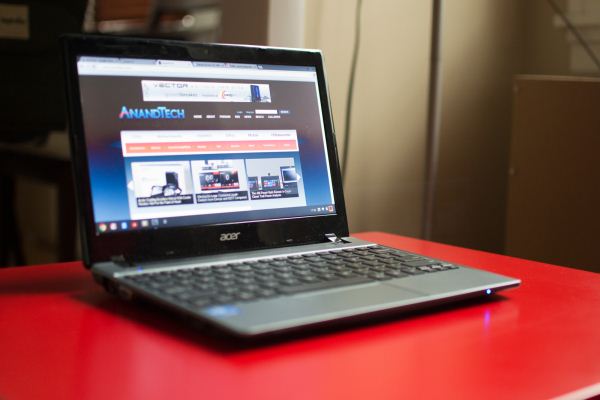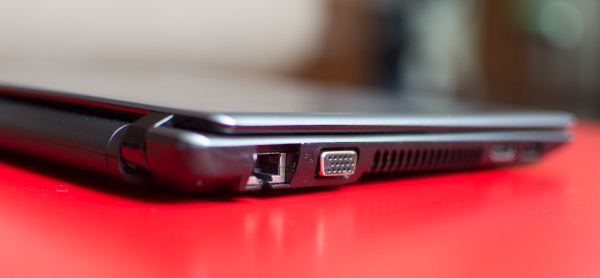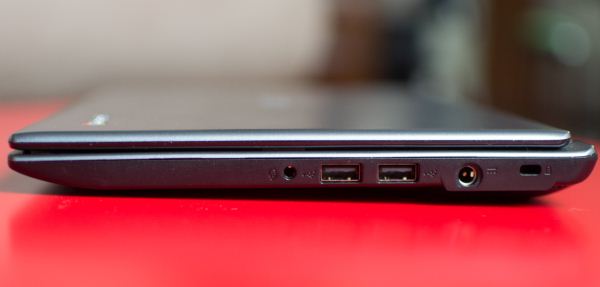Acer C7 Chromebook Review
by Jason Inofuentes on January 21, 2013 12:30 PM ESTIf today we were reviewing the Acer Aspire One A0756-2641 notebook, from which the Acer C7 Chromebook is derived, then it would be really brief. Compromised, and too expensive. Priced at around $329, the spec sheet is spared utter embarrassment by having a low-end Sandy Bridge processor, rather than something from the Atom line. Aside from that, it’s hard to argue in favor of this notebook when a little more cash can net you a small caching SSD, more RAM, a better processor and a goodly performance boost. But this isn’t the Acer Aspire One. This is the Acer C7 Chromebook, and it only costs $199. Does that make all the difference? Let’s take a look.
In consumer electronics, every market segment goes through this moment when the technology becomes affordable enough that it becomes a race to the bottom. The netbook movement pulled the floor out from under notebook prices, and the results were, at first, severely compromised and almost unbearable. The long term result of the ensuing price pressure means a fantastic Windows laptop can be had for well under $1000. Much of this is owed Intel’s fabs (and marketing) and we are in an era of high IPC, power efficient and cheap x86 processors powering notebooks of all shapes and sizes.
The full promise of the netbook was never truly acheived, though. There are no “good enough” Windows notebooks available for under that magic $200 barrier. Today’s Atom lacks the oomph to make the user experience one we’d recommend. Move up to a more modern Intel CPU, though, and you get a better experience, but a higher price. So what happens if you take the aforementioned Acer Aspire One A0756-2641 (a Windows 8 notebook with an 11.6” screen and a Sandy Bridge-based Celeron processor with Intel HD Graphics and a 320GB HDD and 2GB of RAM) but stripped out that Windows license and charged $199 for it?
Let’s talk turkey. Thin, flexible plastic does not inspire confidence, nor does it feel good against your finger tips. That’s something we’ve known for a while, long before the materials experienced a resurgence as the netbook movement really grew its wings and become the benchmark for cheap notebooks. You can make the millimeter thin composites look good, and you can even give it an internal structure that is rigid, but it will always feel cheap.
The Acer C7’s design isn’t terrible. As a color-blind person, I really am much more comfortable around grey-tone products, I never have to worry that I’m secretly wearing purple pants. What kills me is a poor tactile experience. So I was surprised to discover that the cheap plastic forms a pretty solid feeling device. When you hold the chassis in one hand, opened, you can feel the plastic body flexing in your hand, but there’s still enough rigidity that you might be convinced it could survive a short fall. The display’s hinges are solid with no jiggle or dead space, and can be laid nearly flat.
The keyboard is narrower than the best of them, but isn’t so cramped that typing becomes a chore. Proper QWERTY alpha/numeric key placement is a must for me, and here the C7 acquits itself well. The keys themselves are well sprung, if a little shallow, and provide good feedback that they’ve been sufficiently depressed. The directional keys are a bit minuscule, and that can be frustrating, particularly given that you may use them more than the trackpad for making selections.
The touchpad is wider than I expected, and fills nearly the full distance from the keyboard to the edge of the device, but is sadly made of the same cheap plastic as the rest of the body. The result is that, though the body feels solid and the mechanical components are sufficient, there’s just nothing particularly pleasing to touch. The touchpad’s performance is also a bit lacking. Two finger scrolling works well enough, but pinch to zoom was hit or miss and not supporting additional gestures makes it almost impossible to accurately select text or drag a file. For accuracy’s sake I prefer the directional keys, their size not withstanding.
While the base of the C7 tapers down towards the user, the display body is a uniform depth and a bit thicker than I might have hoped. Despite its thickness, with just a mild bit of force you can flex the display pretty radically; not a confidence inspiring trait. Bezels aren’t too radical, and the camera is centered within the top bezels, with the Acer logo below the display.
With the base tapering to a slim edge, the bulk of the laptops weight is in the battery towards the back of the device. Along the bottom of the C7 are myriad vents and labels, and a pair of speaker grills. A single screw beneath a warranty sticker restricts the removal of the bottom panel; and our review sample just happened to be missing that screw entirely. With no screw in the way it’s quite easy to slide the panel off and have access to the hard drive, RAM and wireless module, along with a close look at the cooling mechanism. The left side houses the ethernet and VGA ports on one side of a rather large vent, and HDMI and USB 2.0 on the other. The right side sports the Kensington lock port, power, 2xUSB 2.0 and headset port. Along the front edge are power and charging indicator LEDs, and a sprung SD slot with a molded blank to fill it when the slot isn’t being used.
The C7’s two speakers sit on the beveled edge of the C7, below the wrist rest. Their output won’t rattle your windows, and might not be enough to hear clearly from across the room, but they’ll do from arm’s length.





















63 Comments
View All Comments
s44 - Monday, January 21, 2013 - link
As a second device, this is terrible. Active cooling, mechanical storage, total crap battery...No way should anyone buy this over the ARM Samsung.
lwatcdr - Monday, January 21, 2013 - link
Actually I can see a lot of people using this as their only computer. If you do not game then this is ideal for a good number of home users. Thing of what a lot of home users do.1. Facebook,
2. Amazon.
3 Banking/investments.
4. Email.
5. Netflix.
6. YouTube.
7. Pandora.
8 if a student writing papers.
Will it do Netflix? Doesn't netflix use .Net?
A lack of a spotify app could be an issue but then again RDIO doesn't need an app.
Google Docs is good enough for a lot of folks. With more and more moving to the web this really does make some sence for users. I would probably put Ubuntu on it but that is just me.
tech6 - Monday, January 21, 2013 - link
The problem with Chromebooks is the Chrome OS which is, at best, a Google side project. It's feels incomplete like an early beta release and the resulting compromises make it overpriced even at $200.sprockkets - Monday, January 21, 2013 - link
I guess the Nexus 10 review is permanently shelved...mayankleoboy1 - Monday, January 21, 2013 - link
+1.Still waiting for that.
Death666Angel - Monday, January 21, 2013 - link
The performance figures are really bad in my opinion. The A15 is dangerously close to the SNB Celeron. I am looking forward to more tests between those chips. And I wonder what the implications are for the 13W IVB/10W Haswell chips.As for the laptop itself, it costs between 231€ (amazon.co.uk) and 269€ (.nl shop) in Europe, which means it competes with AMD E and C processor based notebooks (starting at 200€ without OS and 270€ / 300€ with full Win7/8 OS) and I don't see any advantage for this one.
cosminmcm - Monday, January 21, 2013 - link
What performance are you talking about? This Celeron is the lowest SB can go, it has no HT, no turbo and works at 800 MHz. Anything at a higher frequency would make the difference enormous. And Ivy would only add to that and lower the power consumption.An AMD E or C would be comparable to the Atom and lose to this Celeron too (800 MHz vs 1700 MHz).
Death666Angel - Monday, January 21, 2013 - link
I didn't draw a performance comparison between the Celeron and the E and C AMDs, I only drew one between the A15 and the Celeron. Yes, it is the lowest one out there and it is clocked even lower. But considering that it is still a chip from Intel, done on a competitive and proven 32nm process with a 17W TDP, the performance delta over the A15 is pretty low in my opinion. And the 13W TDP IVB and low power Haswell chips will get there by significantly reducing clocks as well. I'm not saying it is slower, but considering everything Intel has over the other chips manufacturers, such a small lead is surprising to me.DanNeely - Monday, January 21, 2013 - link
Celeron chips are Intel's not quite worthless dies salvaged for whatever they can get away with selling them for. They've always had horrid performance/watt numbers. The fact that a near garbage grade 2 year old design is still competitive with the best that Arm has to offer says something completely different; as does Intel's 17W IVB chips being nominally upto ~4-7x faster (dual core, HT, and 1.9-2.8ghz). Chop that in half to look at a single core and you're at ~2.3.5x the performance for only marginally above the A15's max power; do the same with the 13W TDP part (1.5-2.4 ghz) ~2-3x performance at a slightly lower TDP.extide - Monday, January 21, 2013 - link
That Celeron may be rated at 17w TDP, but I bet it doesnt even get CLOSE to that in reality. It's probably more in the 5-7W realm realistically. Think about it, 800Mhz, very little cache, no HT, no Turbo... Also considering that the Exynos 5 is running at up to 1.7Ghz, which is over twice the clockspeed, it firmly puts the performance differences into perspective. The Intel chip is straight up smoking that ARM chip.